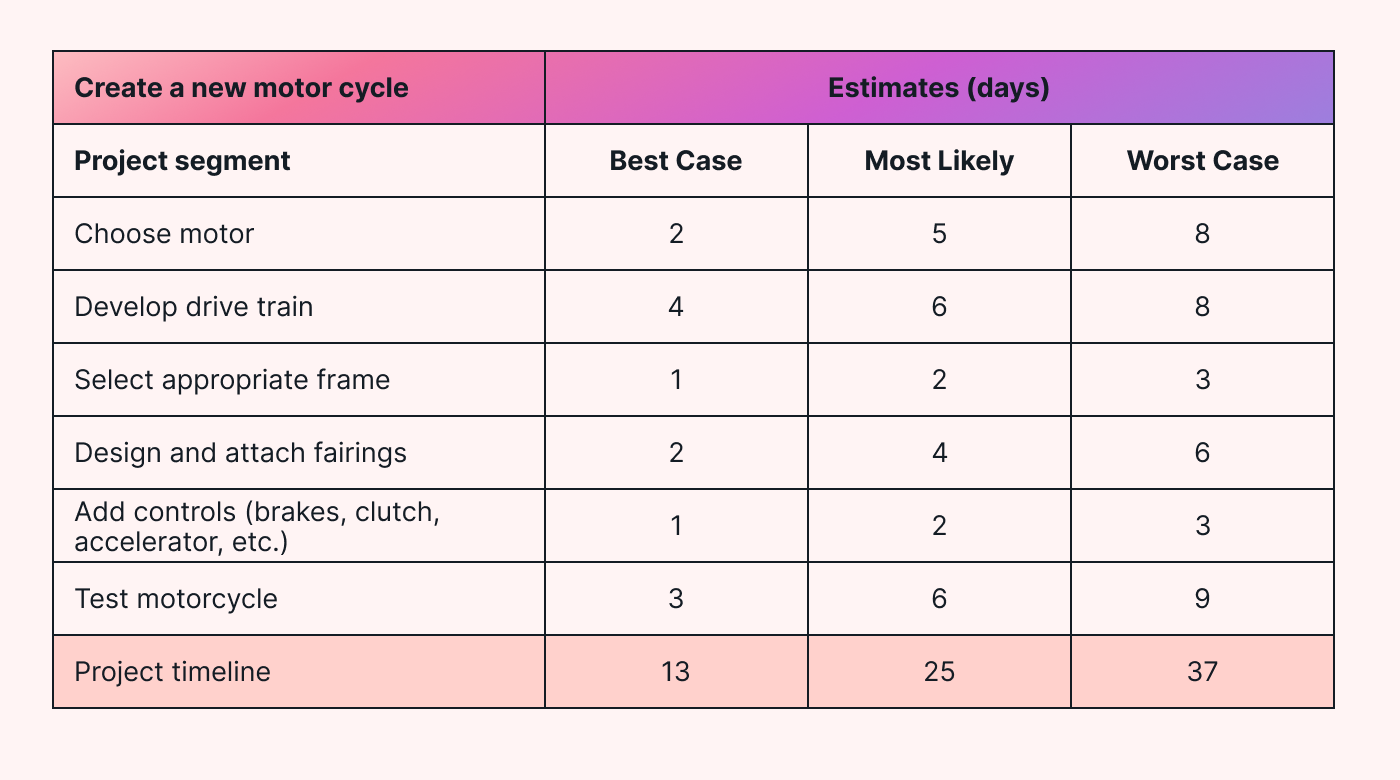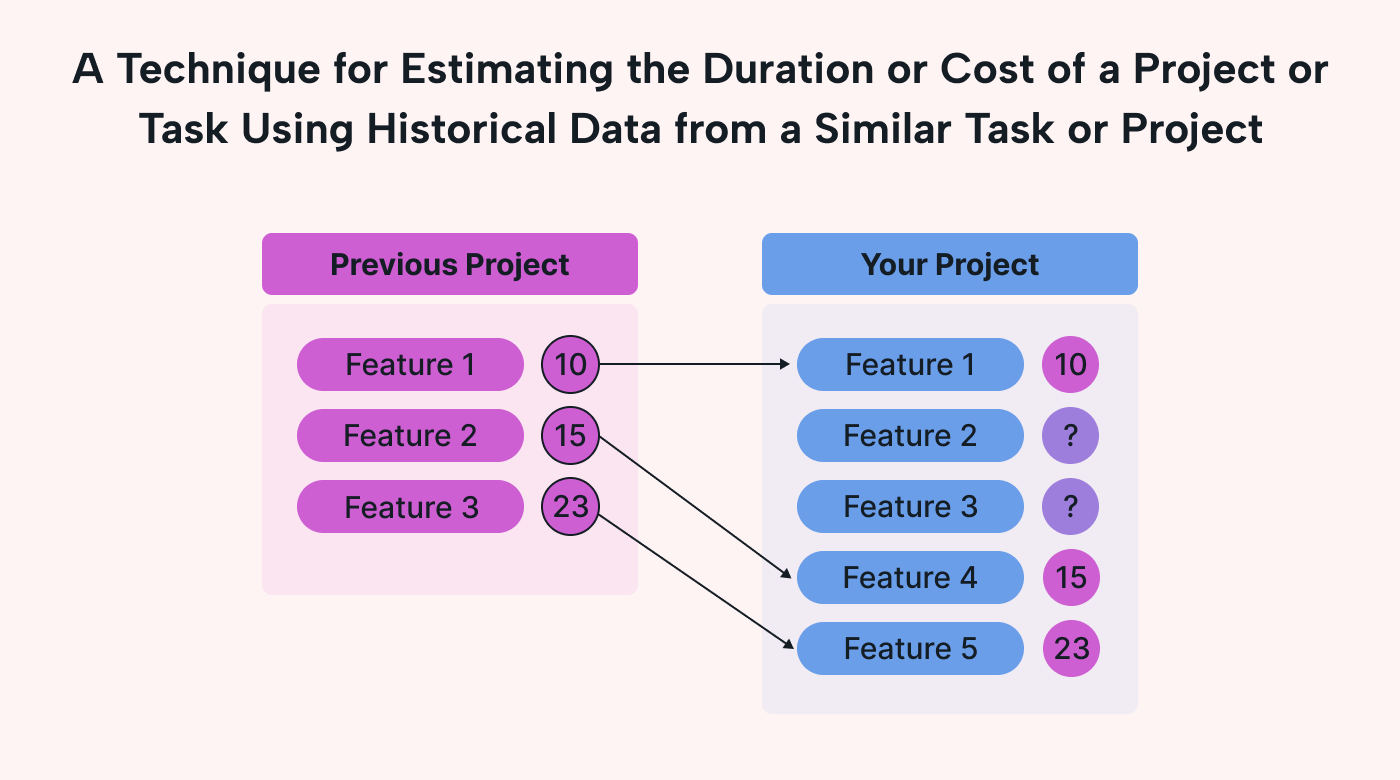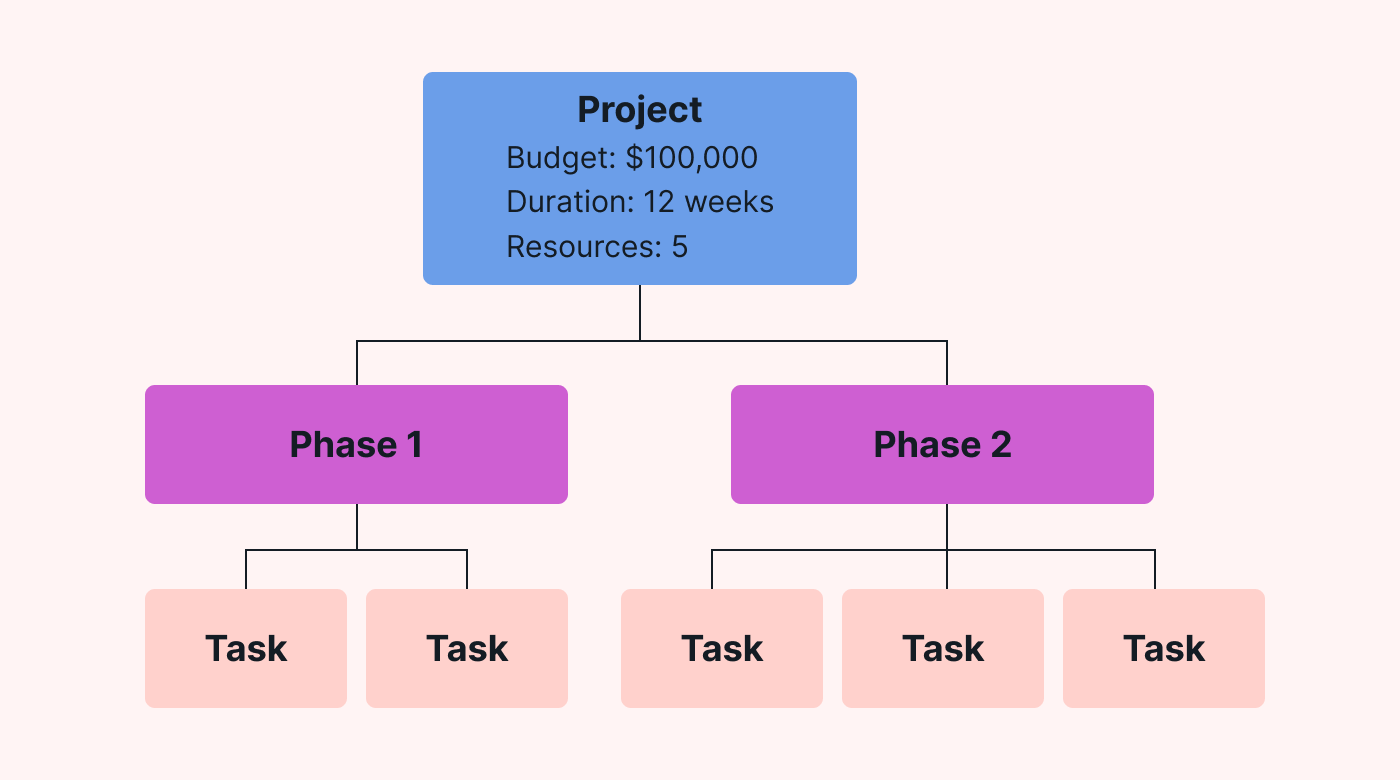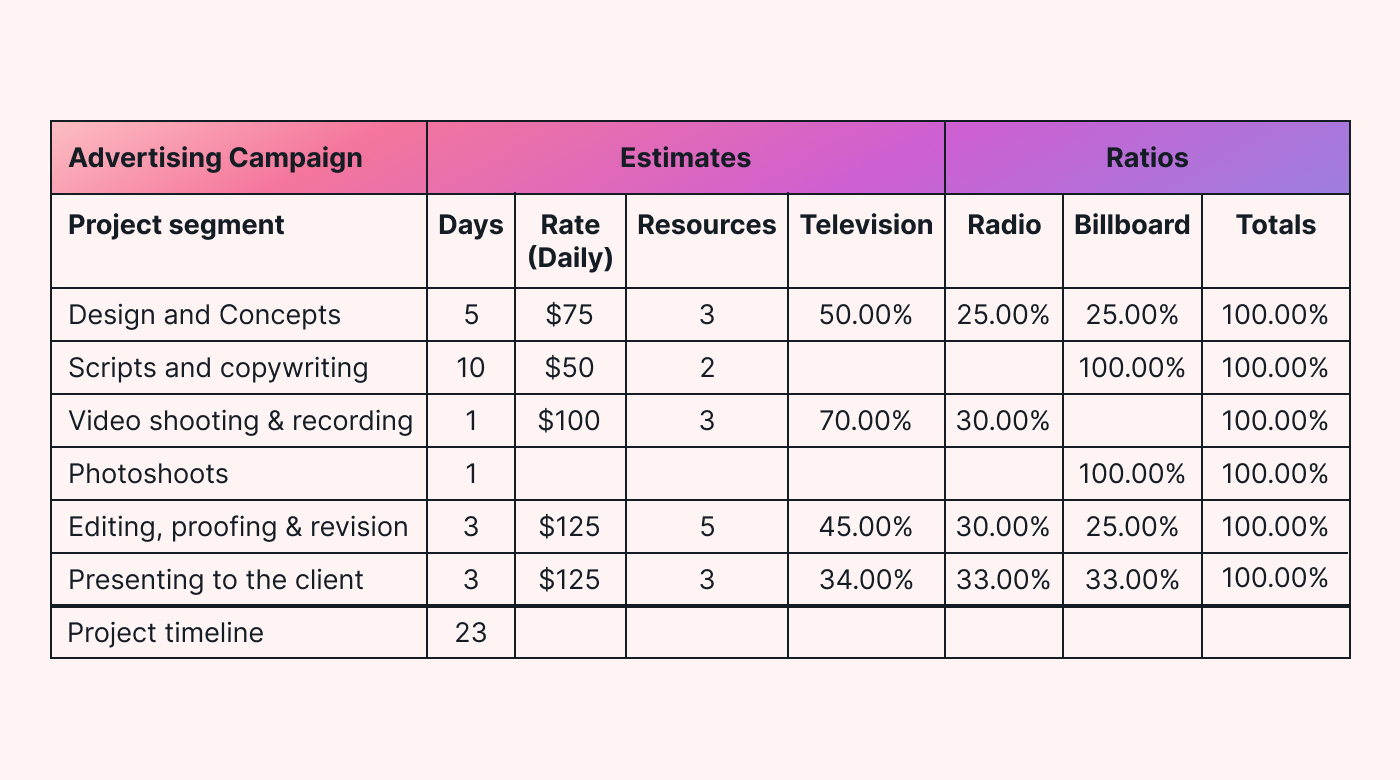You can use many tools and techniques in project management when planning and executing your projects. One such method is analogous estimating, which is often misunderstood as only a way to do cost estimates for a project. In fact, it’s much more than that.
But first let's take a step back and look at projects more generally. There's a principle called the project management triangle or triple constraints. It's based on managing the three elements of time, cost and scope. Focusing on these factors gives project managers an excellent chance of delivering a successful project.
Analogous estimation is one of the many techniques you can use to accomplish estimation of time and cost given the scope. As the name suggests, you compare the time or cost of your new project to one or more previous but similar projects .It’s a way to establish a preliminary estimate for duration and / or cost for your new project.
Types of analogous estimation
The approach uses data collected from previous projects to forecast the likely needs of your current project. That sets your project up for success and gives your stakeholders a handle on the potential costs, timeline, and resources you’ll need. There are three main methods of analogous estimating.
One-point estimate
Also called an absolute estimate, this involves comparing a single data point or value. If you're looking at a similar past project that cost $100,000 to complete, you could use that figure as a preliminary budget for your new project.
Alternatively, if the projects are similar enough and the earlier one took 12 weeks, you could use that as an estimated timeline for your future project, or vary it based on some identified differentiator.
You could also take it further by making comparisons during the project, for example when starting or ending a phase. This helps you recalibrate your estimate, or compare how well your team performs versus the team that worked on the earlier project.
Ratio estimating
You’d use this method when the previous project you’re using for comparison is similar in type but different in scale: smaller or larger. The first step would be to establish the ratio between the two projects.
For example, suppose you’re developing a new website and a previous similar project took your team three months to complete. You’d look at historical data or consider the experiences of the older project first. Then, you may decide that your new project is roughly twice as big or twice as complex.
Consequently, you’ll work out that you’ll need six months to complete the new website. You could apply the same or a different ratio to estimate the cost and scope of your current project.
Range of estimates
The third method involves finding a range of possible values. A key benefit of range estimating is that it allows you to factor in uncertainty and variability, which is typical of project work.
 |
The main disadvantage is that it’s a lot more work. As reflected in the image above, you must find more than one data point for each project element. In this example, we’re looking at three scenarios for developing a new motorcycle: best-case, most likely, and worst-case.
You are working towards the most likely value, but you’re making allowances for over- and under-achieving your project tasks. The technique allows you to bring some variation into your estimations.
Where to use analogous estimating
The beauty of analogous estimating is that it can be done when you have limited data on your current project. This is because it relies on data collected from historical projects. And the more data you have, the better the comparison will be and the more accurate an estimate you’ll get.
That makes data from at least one previous project essential for using this technique. You’d have a problem if you don’t have the data from a similar project for comparative purposes. In that case, you’d be best advised to use a different project estimation technique.
Advantages of analogous estimating
Every technique used in a business or on a project has pros and cons. Analogous estimating is no exception. It:
- It doesn’t usually need many resources or time.
- It can be used when you have very little available data.
- It is ideal for the early phases of a project, such as a proposal or initiation.
- It is useful where information about project tasks is limited and historical data are plentiful.
- It can support high-level assessments and strategic decisions.
- It is often chosen for initial estimates, refined with more data, or replaced by another estimating technique.
Disadvantages of analogous estimates
The cons are what'll more than likely make or break a decision to use analogous estimating:
- Due to a lack of data, estimates can be rough and inaccurate.
- The technique relies on the assumption that the past project is similar enough to apply to the new project, but that assumption sometimes turns out to be false.
- Politics or pressure can override project-specific characteristics and the advice of experts on the subject.
- The high-level nature of analogous estimates limits their application to decision-making or project planning at a much lower project task level.
 |
When to use analogous estimating
As already indicated, this type of estimation is often used in the early stages of a new or proposed project. Or it can be used when you have limited information on your project. It’ll generally be the tool you use to provide that first indication of the project’s cost, how long it’ll take, and what resources it’ll need.
And it’s often the only estimate required during the project. It’s generally not used once the project actually begins. It may be if you’re using it to estimate for a new major phase that has analogous counterparts. But it’s generally used as an up-front technique.
How to use analogous estimating
Successful use of this technique depends on choosing a past project that is as similar as possible to the new one. Once you have found that project, you can identify tasks and elements relevant to both projects and then use data from the past project to develop an estimate for your new project.
Project managers will usually follow a five-step process to get there:
- Compile a list of similar projects you or the team have done.
- Collect data for each project, including cost, duration, activities, and scope.
- Build a shortlist for each of the specific similarities to your new project.
- From the data collected, determine which data points are most appropriate to compare based on their strengths and the needs of your project stakeholders.
- Do the estimations for the new project.
Analogous estimating…
This is by no means the only estimation model used for projects and it’s definitely worth comparing it to other common techniques. The comparison should be very helpful if you’re still not sure which technique you should use on your project.
Vs. top-down approach
As the name implies, this technique begins with an overall estimation of the cost, duration, and resources needed for the project. Then, a process of drilling into the details begins using a combination of project expertise and experience on past projects. It goes much deeper and needs more data than analogous estimating.
 |
Where analogous estimating doesn’t usually go beyond the headlines, the top-down approach drills into the details of the current project. And the deeper the project manager drills, the more accurate you can expect the estimate to be.
Vs. bottom-up estimating
You probably guessed it from the name: This is the exact opposite of the top-down approach. But it's completely different in another way, too. The bottom-up estimating process begins with individual project tasks. First, you figure out how much each will cost and how long it'll take, or the effort it will take. Then, you add all that together to give you the final project estimate.
It's a far more accurate technique than analogous estimating, but it also takes a lot longer to arrive at a project estimate. That wouldn't work too well if you were under time pressure to get the estimate out. And it would require much more knowledge about the work breakdown structure and resources required than analogous estimates.
Vs. parametric estimating
In some ways, this technique is similar to analogous estimating. Parametric estimation also uses past project data but takes a more detailed approach. You need to manipulate that data to find similarities and differences between the projects.
In this way, you define the parameters for a particular project type and can provide a blanket estimate. For example, construction companies use it to calculate a cost per square foot, which makes quotations easier. These parametric estimates are likely to be more accurate because we're diving deeper. But they also need more time than analogous estimating.
The type of project could also prevent you from using parametric estimating. Imagine trying to find an equivalent project parameter to cost per square foot when you’re developing software or advertising campaigns. Those, of course, could have their own parameters.
Vs. three-point estimates
This technique is similar to the range of estimates framework sometimes used with analogous estimating. But it’s far more detailed because you approach it from a task level, assigning three figures for each: an optimistic estimate, a most likely estimate, and a pessimistic estimate. Your assessment is based on the average of those numbers and likely to provide an accurate estimate.
One of the benefits of the three-point estimating technique is that you can calculate a weighted average rather than a simple one. It also lends itself to using a PERT distribution to calculate the probability of achieving your expected project duration.
 |
Again, the devil is in the details: three-point estimating is more accurate but it takes longer to do than analogous estimating.
Vs. what-if analysis
This technique also takes a lot of time because it typically involves meetings with stakeholders and the project team. It’s useful when you want to get buy-in from your stakeholders or when the project is in a field that’s completely new to you. Or when you want to examine and estimate cost or time with various scenarios.
It’s a brainstorming-style project estimation approach that can scale down to smaller groups and work packages. The differences between this technique and analogous estimating are, as you’d expect, the detail, the accuracy, and the time required.
Vs. expert judgment
This is the estimating technique that’s most difficult to quantify. That’s because it relies on the experience and gut feel of people who have done it before. They could be people on your team, external experts, someone in the project management office, or they could be you, the business owner or project manager.
Expert judgment is comparable to analogous estimating in terms of the speed of estimation. But it’s likely to be more accurate because of the weight of all that expertise. However, skills and experience like that may be expensive. So, if your experts aren’t already on board, it’ll probably cost much more for that project estimate.
An example of analogous estimating
When you think of projects, you’d usually imagine construction or infrastructure projects and, possibly, IT projects. But the truth is that almost anything can be a project. It could be a landscaping project. Putting a magazine together could be a project, often involving several freelance contractors.
Creating an advertising campaign can also be treated like a project. A typical ad campaign may include TV, radio, print, online ads, and billboard advertisements. Or maybe just a few of them, like our example: TV, radio and billboards.
Most advertising agencies will have done all those things before, so they’ll have plenty of data from those projects. They’ll also be pressured to produce client proposals to win the orders. That makes it a perfect environment for analogous estimating, specifically using ratios.
They’ll know how long it takes and how much it costs to create a typical TV, radio, and billboard advertisement. Based on the client briefing, they can assess whether this project will be more or less in each area and by how much.
 |
Use estimating to make your projects fly
Using analogous estimation on your projects doesn’t have to be complicated. But it’ll help you make better informed financial decisions and develop an initial understanding of the project costs, time, and resources you’re likely to need for project success.
If that sounds daunting, it doesn’t have to be. With Motion’s AI-powered project management app on your side, you have an assistant who never needs a break. It can craft your team’s schedules and tailor them to your priorities while keeping track of their progress. When things change, it automatically shuffles the affected schedules.
From the initial estimation and budgeting phases through constant and ongoing monitoring, control, and project management, Motion helps you keep your project on track. Try the 7-day free trial now and watch your project fly!

After 40-odd years of working in technology, project management, media, and marketing, Brian's career and growth journey has exposed him to a wide range of niches. He brings this breadth of knowledge and expertise in his content work through enriched storytelling and original concepts that make SaaS content engaging and accessible for readers of all stripes.





